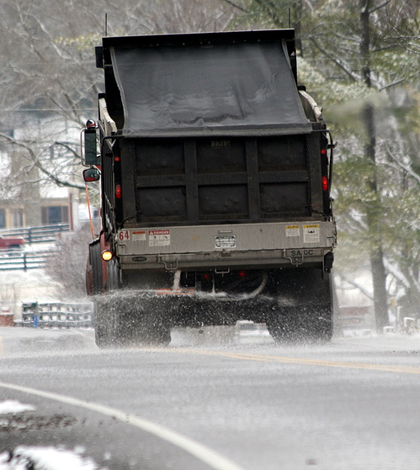Road salt chlorides creeping into Mass. town’s drinking water aquifer

Though the Northern U.S. is easing out of winter, some troublesome effects of the season don’t go away with warmer temperatures. The road salt that helps keep icy roads safe is making its way into a Massachusetts aquifer, apparently contributing to climbing chloride levels in that could eventually make a town’s drinking water unsafe.
For the past ten years, the town of Norwell, Mass., has measured growing concentrations of sodium and chloride concentrations in its drinking water. An ongoing groundwater study from researchers at Boston College and other institutions has helped pinpoint road salt as the cause.
In March 2011, researchers installed piezometers at 30, 45 and 60 feet below ground near the public water supply well where the town has detected the highest chloride concentrations. The sensors measured specific conductance, which can be related to chloride concentrations, every 15 minutes.
By October 2012, a clear pattern in the data had emerged. Chloride concentrations at 30 and 45 feet were higher than they were at 6o feet. The higher concentrations at the shallower sensors indicate that the chloride contamination is coming from the surface, according to Jacob Anderson, a master’s student in earth and environmental science at Boston College and member of the research team.
“By having the data at different depth intervals, you can start to reconstruct what this contaminant plume might look like and where it’s originating from,” Anderson said. “If you can imagine a plume of contamination coming from the surface, you would intuitively expect the highest concentrations near the surface below a road, and that concentration would decrease as you get farther away from the contamination source.”
At its 60 feet down, the deepest sensor lies near the point where public well draws water. While concentrations are lower down there, they’re growing.
“If you look at that trend line, it’s increasing around 10 or 11 parts per million per year,” Anderson said. “If that trend is continued, it’s going to cross the EPA’s contaminant level limits for chloride in 2019 or 2020.”
In another round of data collection in March 2012, the researchers collected near-surface groundwater samples from 11 sites near the public wells. Chloride concentrations were generally higher near roads, again indicating that road salt runoff is the culprit.
The high-and-rising chloride levels are concerning because the contaminants aren’t removed by normal drinking water treatment processes. That would require reverse osmosis, a more expensive and energy-intensive treatment.
But there are other solutions, Anderson said. There are best management practices to apply less salt. And there are also ice-melting alternatives to salt, including other chemicals and bio-deicers.
The salt alternatives tend to be more expensive than road salt, but that’s only the case when comparing direct costs, Anderson said.
“If you think about the cost of corrosion to bridges and cars, and if you think about the human health impacts and the environmental impacts, the true cost of using (road salt) is probably closer to some of the alternatives. It’s just less tangible.”
Top image: A truck spreads road salt in Tennessee (Credit: Daniel Johnson, via Flickr)




0 comments